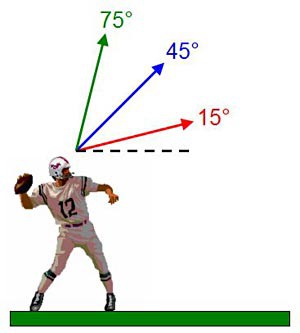Summary

Introduction
Have you ever seen a game-winning “Hail Mary” pass in a football game, a baseball player throw in a ball from way out in the outfield, or a soccer goalie punt a ball all the way down the field? All of these actions involve a player trying to throw or kick a ball as far as possible. There is some sports science behind these throws and kicks – how do you know what angle to throw or kick the ball so it will go the farthest? Should you make a shallow throw (straight out, parallel to the ground), a steep throw (throwing the ball high up in the air), or something in between? Try this sports science project to find out!
Background
An object that is thrown or launched through the air is called a projectile. The study of how projectiles move through the air is called projectile motion, and is something you will learn early on in most physics classes. When a projectile is launched, it has an initial velocity (the speed and direction of motion). When a projectile is moving through the air, it is subject to the force of gravity, which causes it to accelerate down towards the earth. It is also subject to the force of air resistance, which slows the projectile down.
When air resistance is very small, a projectile moves in the shape of a parabola (a type of mathematical curve – do an internet search for “parabola” to see what one looks like). The path the ball follows (called its trajectory) will determine how far it goes before it hits the ground. Adjusting the initial angle of the ball, while keeping its initial speed constant, is one way to find out the best angle to throw a ball as far as possible. In this experiment, you will throw (or kick) a ball as hard as you can, while changing the ball’s initial angle relative to the ground. What angle do you think will make the ball go the farthest?
Materials
- Ball of your choice (football, soccer ball, baseball, etc)
- Large open area to throw or kick the ball
- Three different types of object to mark where the ball lands on the ground (could be anything – sticks, rocks, leaves, etc)
- Helper
Preparation
- Make sure you have a large, open area to throw or kick the ball, and that there are no other people in the way.
- Do some stretching or warm-up exercises before you start the experiment – it will involve a lot of throwing (or kicking)!
Instructions
- Pick a place to stand in your large, open area. Mark a place on the ground so you know to always throw or kick the ball from that location.
- Pick a direction to throw or kick your ball (if it is a windy day, make sure you pick a consistent direction relative to the wind).
- Throw or kick your ball as hard as you can, relatively straight forward at a shallow& angle. If you know how to measure angles in degrees, imagine trying to throw the ball at about a 15 degree angle relative to the ground.
- Have your volunteer mark where the ball lands (for example, with a rock).
- Repeat the throw at that angle two more times. Try to consistently throw the ball as hard as you can, so its initial speed is constant. Have your volunteer mark each through.
- Now, repeat the procedure for a “medium” angle (outward and upward) of about 45 degrees. Remember to try and consistently throw the ball as hard as possible.Use a different type of marker for where these throws land.
- Now, repeat the procedure for a “steep” angle (up in the air and slightly forward, but not straight up), of about 75 degrees. Remember to try and consistently throw the ball as hard as possible. Use another different type of marker.
- Now, analyze the results of your experiment by looking at the markers. Which throws went the farthest? What angle do you think is best if you want to throw or kick the ball as far as possible?
Extra: have a second volunteer film your throws from the side. You can analyze a video of your throw to track the trajectory of the ball using many smartphone apps or a computer program like Tracker.
Extra: try the experiment using different types of balls. Do you get different results?
Observations and Results
In most cases, you should see that a 45 degree angle made the bar go the farthest. When you throw the ball at a very shallow angle, gravity pulls it down to the ground very quickly, so it does not have as much time to travel very far forward. When you throw the ball at a very steep angle, most of its velocity is directed upward instead of forward, so it does not make much forward progress.
However, depending on the type of ball and the amount of air resistance on the ball, you might see different results. A ball that has a lot of air resistance (like a whiffle ball) might slow down significantly when it is in the air for a long time, so it might actually go farther at a shallow angle.
Ask an Expert
Additional Resources
- Science Activities for All Ages!, from Science Buddies
- How Far Can You Throw (or Kick) a Ball?, from Science Buddies
- Projectile Motion, from the Physics Classroom




